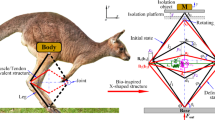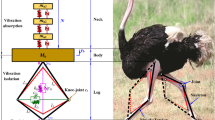Abstract
Inspired that the neck structure can stabilize the head from body movements and external dynamic vibration by the role of intervertebral disc and surrounding muscles, a novel multi-layer structure with nonlinear elastic components is proposed in this paper. The proposed structure is expected for loading the weight of the end effector and isolating bending vibration with low-frequency in the range of 0.1 Hz to 1 Hz. First, considering the loading, the potential energy, restoring force, and structural configuration in axial direction are defined. Then, the dynamical restoring force and stiffness for bending are modelled for different structural parameters and configurations after the axial weight. According to the functions of the proposed structure required in applications including loading capacity and bending vibration isolation effectiveness, design criteria are carried out. Due to the realization of high-order quasi-zero stiffness property, the effective isolation band for bending vibration can be extended from about 0.08 Hz. In addition, based on the proposed design criteria, the constructed multi-layer structure displays remarkable dynamical stabilization effectiveness in ultralow frequency band. The proposed structure not only provides the biological explanations for car sickness, nausea, and airsickness of humans, but also solves the bottleneck techniques in bio-inspired nonlinear isolation structural design for transverse dynamical stabilization, which has remarkable potential applications in the fields of mechanical arm, sensors in satellite etc.
摘要
基于椎间盘和周围肌肉的共同作用, 颈部结构在外部振动下可以保持头部稳定. 受此启发, 本文基于椎间盘构型和肌肉作动机制提出了一种新型仿生多层隔振结构. 该结构具有足够的承载能力, 并且实现了对0.1~1 Hz范围的超低频激励的振动隔离. 首先, 在荷载作用下, 建立了弯曲变形下的势能、 恢复力与单层结构构型的关系; 其次, 基于非线性隔振结构高承载能力和低动态刚度的需求, 提出了满足轴向承载的高阶零刚度设计准则, 将该多层隔振结构弯曲振动的有效隔振频带起始点向低频范围扩展至0.08 Hz. 结果显示, 创新构建的仿生多层隔振结构在超低频段内表现出了显著的动态稳定效果. 研究不仅为人类晕车晕船现象提供了生物学解释, 还建立了柔性细长结构横向动态稳定的新结构和新方法, 因此, 其在机械臂、 卫星传感器等领域具有显著的应用潜力.
Similar content being viewed by others
Abbreviations
- L 1, L 2 :
-
the up- and down-linkages of disc structure
- R 1, R 2 :
-
widths of dentata without/with the transverse process
- DSs:
-
diagonal Springs
- SSs:
-
support springs
- BSs:
-
balance springs
- L h0 :
-
original length of the diagonal springs
- L v0 :
-
original length of the support springs
- L b0 :
-
original length of the balance springs
- L hat-r :
-
length of the right-side diagonal springs for bending deformation after the axial deformation
- L vat-r :
-
length of the right-side support springs for bending deformation after the axial deformation
- L bat-r :
-
length of the right-side balance springs for bending deformation after the axial deformation
- y :
-
the axial-direction deformation
- F a :
-
axial-deformation restoring force
- φ :
-
the rotation angle of rigid unit
- \(\hat \varphi\) :
-
the relative rotation angle between the adjacent rigid units
- Mat :
-
bending restoring moment
- \(\widetilde{M}_{at}\) :
-
polynomial expansion of bending restoring moment
- J (j) :
-
rotational inertia of the rigid unit in each layer of structure
- m j :
-
mass of rigid unit in each layer of structure
- T b-j :
-
displacement transmissibility from the base to each-layer of structure
- θ 1, θ 2 :
-
the angles for the up- and down-linkages to vertical direction
- θ 1a, θ 2a :
-
the angles for the up- and down-linkages to vertical direction after axial deformation
- k h :
-
stiffness of diagonal springs
- k v :
-
stiffness of support springs
- k b :
-
stiffness of balance springs
- L ha :
-
length of the diagonal springs for axial deformation
- L va :
-
length of the support springs for axial deformation
- L ba :
-
length of the balance springs for axial deformation
- L :
-
length of the left-side diagonal springs for bending deformation after the axial deformation
- L vat-l :
-
length of the left-side support springs for bending deformation after the axial deformation
- L bat-l :
-
length of the left-side balance springs for bending deformation after the axial deformation
- V a :
-
axial-deformation potential energy
- V at :
-
bending potential energy
- φ z :
-
the excitation angle from the base
- D at :
-
bending dynamical stiffness
- \({\tilde k_n}\) :
-
dynamical stiffness coefficients in the polynomial expansion
- c (j) :
-
damping coefficient for each layer
- T d :
-
displacement transmissibility between two adjacent layers
- T b-n :
-
displacement transmissibility from the base to the top layer
References
J. Huang, Y. Xu, X. Y. Peng, L. Hu, and J. K. Yang, Development of a human head and neck muscle activation control model based on BPNN, J. Intell. Fuzzy Syst. 34, 1161 (2018).
F. Li, R. Lu, W. Hu, H. Li, S. Hu, J. Hu, H. Wang, and H. Xie, The influence of neck muscle activation on head and neck injuries of occupants in frontal impacts, Appl. BIon. BioMech. 2018, 1 (2018).
C. Zhang, X. Meng, D. E. Anderson, W. Wang, X. Tao, and B. Cheng, Effects of stretch reflex on back muscle response during sinusoidal whole body vibration in sitting posture: A model study, Int. J. Industrial Ergonomics 71, 103 (2019).
Y. W. Wang, L. Z. Wang, S. Y. Liu, and Y. B. Fan, A two-step procedure for coupling development and usage of a pair of human neck models, Comput. Methods Biomech. Biomed. Eng. 21, 413 (2018).
T. Yasuki, Mechanism analysis of pedestrian knee-bending angle by sedan-type vehicle using human FE model, Int. J. Crashworthiness 12, 329 (2007).
L. K. Kamibayashi, and F. J. R. Richmond, Morphometry of human neck muscles, Spine 23, 1314 (1998).
B. Frechede, N. Bertholon, G. Saillant, F. Lavaste, and W. Skalli, Finite element model of the human neck during omni-directional impacts. Part II: relation between cervical curvature and risk of injury, Comput. Methods Biomech. Biomed. Eng. 9, 379 (2006).
L. Molinari, C. Falcinelli, A. Gizzi, and A. D. Martino, Biomechanical modeling of metal screw loadings on the human vertebra, Acta Mech. Sin. 37, 307 (2021).
S. M. Swartz, K. S. Breuer, and D. J. Willis, Aeromechanics in aeroecology: flight biology in the aerosphere, Integrative Comp. Biol. 48, 85 (2008).
D. R. Warrick, M. W. Bundle, and K. P. Dial, Bird maneuvering flight: Blurred bodies, clear heads, Integrative Comp. Biol. 42, 141 (2002).
L. Ristroph, G. Ristroph, S. Morozova, A. J. Bergou, S. Chang, J. Guckenheimer, Z. J. Wang, and I. Cohen, Active and passive stabilization of body pitch in insect flight, J. R. Soc. Interface. 10, 20130237 (2013).
L. Ristroph, A. J. Bergou, G. Ristroph, K. Coumes, G. J. Berman, J. Guckenheimer, Z. J. Wang, and I. Cohen, Discovering the flight autostabilizer of fruit flies by inducing aerial stumbles, Proc. Natl. Acad. Sci. USA 107, 4820 (2010).
K. L. McArthur, and J. D. Dickman, State-dependent sensorimotor processing: gaze and posture stability during simulated flight in birds, J. Neurophysiol. 105, 1689 (2011).
N. Yoganandan, J. Moore, F. A. Pintar, A. Banerjee, N. DeVogel, and J. Y. Zhang, Role of disc area and trabecular bone density on lumbar spinal column fracture risk curves under vertical impact, J. Biomech. 72, 90 (2018).
A. Hedenström, and L. C. Johansson, Bat flight: aerodynamics, kinematics and flight morphology, J. Exp. Biol. 218, 653 (2015).
D. L. Altshuler, J. W. Bahlman, R. Dakin, A. H. Gaede, B. Goller, D. Lentink, P. S. Segre, and D. A. Skandalis, The biophysics of bird flight: functional relationships integrate aerodynamics, morphology, kinematics, muscles, and sensors, Can. J. Zool. 93, 961 (2015).
D. Quinn, D. Kress, E. Chang, A. Stein, M. Wegrzynski, and D. Lentink, How lovebirds maneuver through lateral gusts with minimal visual information, Proc. Natl. Acad. Sci. USA 116, 15033 (2019).
A. E. Pete, D. Kress, M. A. Dimitrov, and D. Lentink, The role of passive avian head stabilization in flapping flight, J. R. Soc. Interface. 12, 20150508 (2015).
D. D. Chin, and D. Lentink, Flapping wing aerodynamics: from insects to vertebrates, J. Exp. Biol. 219, 920 (2016).
K. Mazaheri, and A. Ebrahimi, Experimental investigation on aerodynamic performance of a flapping wing vehicle in forward flight, J. Fluids Struct. 27, 586 (2011).
L. Jing, K. Wang, and W. Zhai, Impact vibration behavior of railway vehicles: a state-of-the-art overview, Acta Mech. Sin. 37, 1193 (2021).
F. Zhao, J. C. Ji, K. Ye, and Q. Luo, Increase of quasi-zero stiffness region using two pairs of oblique springs, Mech. Syst. Signal Process. 144, 106975 (2020).
X. Wang, H. Liu, Y. Chen, and P. Gao, Beneficial stiffness design of a high-static-low-dynamic-stiffness vibration isolator based on static and dynamic analysis, Int. J. Mech. Sci. 142–143, 235 (2018).
K. Ye, J. C. Ji, and T. Brown, Design of a quasi-zero stiffness isolation system for supporting different loads, J. Sound Vib. 471, 115198 (2020).
K. Q. Pan, and J. Y. Liu, Geometric nonlinear dynamic analysis of curved beams using curved beam element, Acta Mech. Sin. 27, 1023 (2011).
B. Yan, H. Ma, B. Jian, K. Wang, and C. Wu, Nonlinear dynamics analysis of a bi-state nonlinear vibration isolator with symmetric permanent magnets, Nonlinear Dyn. 97, 2499 (2019).
Y. Li, and D. Xu, Vibration attenuation of high dimensional quasi-zero stiffness floating raft system, Int. J. Mech. Sci. 126, 186 (2017).
F. Zhao, J. Ji, K. Ye, and Q. Luo, An innovative quasi-zero stiffness isolator with three pairs of oblique springs, Int. J. Mech. Sci. 192, 106093 (2021).
X. Sun, J. Xu, F. Wang, and S. Zhang, A novel isolation structure with flexible joints for impact and ultralow-frequency excitations, Int. J. Mech. Sci. 146–147, 366 (2018).
X. Sun, J. Xu, and J. Fu, The effect and design of time delay in feedback control for a nonlinear isolation system, Mech. Syst. Signal Process. 87, 206 (2017).
Y. Zhang, and Q. Cao, The recent advances for an archetypal smooth and discontinuous oscillator, Int. J. Mech. Sci. 214, 106904 (2022).
X. Wang, J. Zhou, D. Xu, H. Ouyang, and Y. Duan, Force transmissibility of a two-stage vibration isolation system with quasi-zero stiffness, Nonlinear Dyn. 87, 633 (2017).
Z. Lu, T. Yang, M. J. Brennan, Z. Liu, and L. Q. Chen, Experimental investigation of a two-stage nonlinear vibration isolation system with high-static-low-dynamic stiffness, J. Appl. Mech. 84, 021001 (2017).
X. Sun, S. Zhang, and J. Xu, Parameter design of a multi-delayed isolator with asymmetrical nonlinearity, Int. J. Mech. Sci. 138–139, 398 (2018).
E. Palomares, A. J. Nieto, A. L. Morales, J. M. Chicharro, and P. Pintado, Numerical and experimental analysis of a vibration isolator equipped with a negative stiffness system, J. Sound Vib. 414, 31 (2018).
J. C. Ji, Q. Luo, and K. Ye, Vibration control based metamaterials and origami structures: A state-of-the-art review, Mech. Syst. Signal Process. 161, 107945 (2021).
G. Yan, H. X. Zou, H. Yan, T. Tan, S. Wang, W. M. Zhang, Z. K. Peng, and G. Meng, Multi-direction vibration isolator for momentum wheel assemblies, J. Vib. Acoustics 142, 1 (2020).
G. Yan, S. Wang, H. X. Zou, L. C. Zhao, Q. H. Gao, and W. M. Zhang, Bio-inspired polygonal skeleton structure for vibration isolation: design, modelling, and experiment, Sci. China Tech. Sci. 63, 2617 (2020).
G. Yan, H. X. Zou, S. Wang, L. C. Zhao, Q. H. Gao, T. Tan, and W. M. Zhang, Large stroke quasi-zero stiffness vibration isolator using three-link mechanism, J. Sound Vib. 478, 115344 (2020).
H. Dai, X. Cao, X. Jing, X. Wang, and X. Yue, Bio-inspired antiimpact manipulator for capturing non-cooperative spacecraft: theory and experiment, Mech. Syst. Signal Process. 142, 106785 (2020).
R. Zeng, G. Wen, J. Zhou, and G. Zhao, Limb-inspired bionic quasi-zero stiffness vibration isolator, Acta Mech. Sin. 37, 1152 (2021).
Author information
Authors and Affiliations
Corresponding author
Additional information
This work was supported by the National Natural Science Foundation of China (Grant Nos. 12122208 and 11972254).
Electronic supplementary material
Rights and permissions
About this article
Cite this article
Sun, X., Qi, Z. & Xu, J. A novel multi-layer isolation structure for transverse stabilization inspired by neck structure. Acta Mech. Sin. 38, 521543 (2022). https://doi.org/10.1007/s10409-022-09039-x
Received:
Accepted:
Published:
DOI: https://doi.org/10.1007/s10409-022-09039-x




